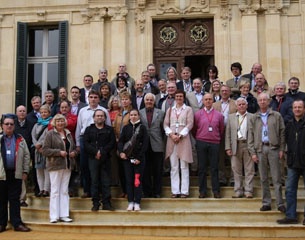
The World Breeding Federation for Sport Horse held its annual assembly in Seville, Spain, on 24 - 26 October 2011. The 2011 GA was hosted by ANCCE, The Spanish national studbook of Pura Raza Española.
Due to the Pan American Games and the FEI meetings in Guadalajara taking place almost parallel with the WBFSH meetings the FEI was not able to send representatives to Seville.
A main goal of the WBFSH is to bridge breeding and sports and thus the relationship with the FEI is very important and I am pleased to say that the FEI also attaches much importance to our co-operation.
The new FEI Secretary General, Ingmar De Vos, was invited to join us here in Sevilla but due to the Pan American Games and FEI meetings in Guadalajara both the President, HRH Princess Haya, and De Vos to their regrets are unable to attend our meetings this year.
In Copenhagen two years ago another player in the horse world and another WBFSH partner was presented, the European Horse Network. This organisation convened an interesting conference in Brussels in November. The aim was to discuss how to proactively influence the upcoming change in the agricultural policy as well as all relevant European policies.
A few of the topics discussed at the 2011 WBFSH General Assembly are listed below:
WBFSH president Jan Pedersen talked about the World Championships for Young Dressage Horses in Verden. He stated that the value of these championships has often been questioned, especially whether they strain the horses too early as well as whether these horses really make it to top sport? In order to answer these questions the magazine, Horse InternationalL, surveyed one hundred of the most successful horses in these championships. 43 of them have reached the highest level. 80 % of the horses in the survey have – by now - made it to Small Tour or Grand Prix. The magazine's conclusion was: “From these high percentages one might assume that a five- or six-year-old’s success at Worlds Championships almost guarantees a high-level sport career”.
The documentation of the high and unambiguous correlation between the results of the young horses at Verden and international top sport makes these championships even more interesting. It was also striking at Verden that the majority of the sires of the horses in the finals have themselves been competing successfully at these championships. "So what we do in Verden and Lanaken does make sense – from a breeding and a sporting point of view," said Pedersen.
X-Ray Harmonization
The WBFSH wishes to harmonize the basis of X-rays standards between countries. It is in particular important to make the exchange of stallions easier. The focus should therefore be on stallions for breeding and not riding horses. Therefore five veterinarians were invited, two from Germany, one from France, one from Belgium and one from Ireland to a meeting in July to discuss this topic.
The WBFSH suggested the veterinarians to work with the following agenda:
1. Definition of a common protocol for the number and projections of X-rays
2. Determination of the number of categories and description of the separate categories
3. Agreement on radiological interpretation
The vets discussed the agenda for a few hours and then reported to the WBFSH joint meeting. They had agreed on item 1 and decided that the minimum of X-rays should be 12 projections. Items 2+3 need several more meetings, not necessarily together with the WBFSH. The veterinarians would like to extend the group with vets from the Netherlands, Denmark and Sweden etc.
They suggested that the group could meet in connection with the examination of X- rays of stallion prior to the stallion selection in each country in order to exchange experience. It was pointed out that there can be differences in the consequences of the findings depending on the policy of the individual breeding association.
Funding is the problem. Paul Hubert is the WBFSH's connection to the vets and he will examine the possibilities of funding.
WBFSH/FEI rankings
Jan Pedersen informed that the FEI/WBFSH rankings have often been criticized for not including the population size. But this was not as simple as it sounded. Therefore the Board had asked Daniëlle Arts from the Department Promotion to illustrate the problems.
The purpose of the rankings is to compare the studbooks based on FEI/WBFSH horse rankings. The 6 best horses from each studbook are added together and they establish the studbook rankings per disciplines. The higher a horse is ranked, the higher score is added to the studbook. The problem is that differences in population size and breeding goals make the comparison difficult.
A journalist had recently produced an alternative ranking list by using the 300 highest ranked horses and taking an estimated number of foals born per disciplines into the calculation. Daniëlle Arts showed that the rankings would differ hugely if only top 100 compared to top 600 are used. So which ranking list would be the most correct one?
The conclusion was that the rankings were highly sensitive. To correct for studbook size the WBFSH would need the exact number of foals born per discipline. Furthermore all studbooks and not just top 300 should be in the rankings. Until these figures are available from all studbooks it is better just to keep the rankings as simple as possible.
Complete minutes here.
Related Links
Minutes of the 2010 WBFSH General Assembly
The Inaccuracy of the WBFSH Ranking
2009 WBFSH General Assembly in Denmark and Sweden
President’s Report of the 2008 World Breeding Federation for Sport Horses Assembly